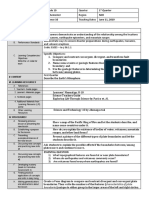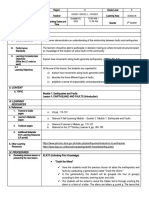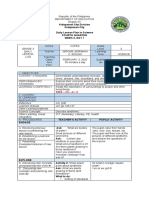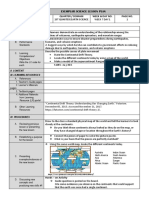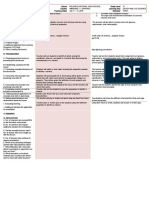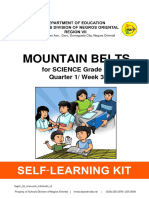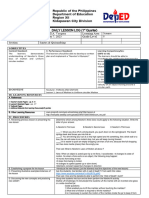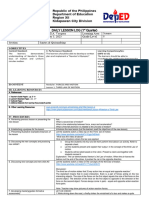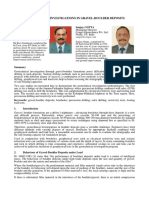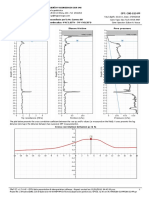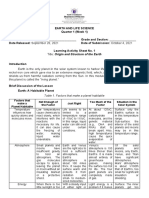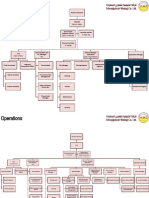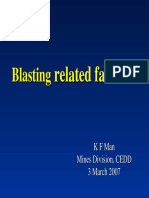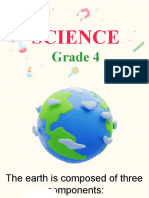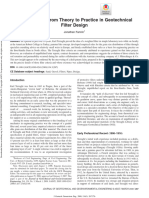Day 1
Day 1
Uploaded by
Ela Anjell AmparadoCopyright:
Available Formats
Day 1
Day 1
Uploaded by
Ela Anjell AmparadoOriginal Title
Copyright
Available Formats
Share this document
Did you find this document useful?
Is this content inappropriate?
Copyright:
Available Formats
Day 1
Day 1
Uploaded by
Ela Anjell AmparadoCopyright:
Available Formats
Republic of the Philippines
Department of Education
Region XII
Kidapawan City Division
D A I L Y L E S S O N L O G (1st Quarter)
School LINANGKOB NATIONAL HIGH SCHOOL
Teacher ELA ANJELL C. AMPARADO Learning Area Science
Teaching Dates July 29, 2024 Grade Level 10
Time 9:15 – 10:00 A.M – 2:30 – 3:15 P.M
Section 10 - EINSTEIN/NEWTON
I-OBJECTIVES
A. Content Standard: The learners B. Performance Standard: The learners shall be able to C. Learning Competency/ies:
demonstrate an understanding of the 1) demonstrate ways to ensure disaster preparedness Describe the distribution of active volcanoes,
relationship among the locations of during earthquakes, tsunamis, and volcanic eruptions earthquake epicenters and major mountain
volcanoes, earthquake epicenters, and 2) suggest ways by which he/she can contribute to belts.
mountain ranges government efforts in reducing damage due to S10ES – Ia-j-36.1
earthquakes, tsunamis, and volcanic eruptions D. Objective/s:
Describe two types of crust.
II-CONTENT Plate Tectonics
III- LEARNING RESOURCES
A. References
1. Teacher’s Guide Page/s: 3 – 6 2. Learner’s Materials Pages: 3 – 6 3. Textbook Pages: _____ 4. Additional Materials from learning
Resources(LR) portals:
B. Other Learning Resources
IV- PROCEDURES
ELICIT
Ask students to recall what they have previously learned about Earth's
A. Reviewing previous lesson or presenting the
new lesson structure and the different layers
ENGAGE 1. Show a video clip or images of the Earth's crust and ask students to
B. Establishing a purpose for the lesson describe what they see.
2. Conduct a class discussion on the importance of studying different
types of crust.
3. Present a real-life scenario where understanding crust types is
crucial and ask students to share their thoughts.
EXPLORE Activity 1: Crust Model
C. Presenting illustrative examples/instances of
the lesson
Materials: Playdough, markers, index cards
Instructions:
1. Divide the students into small groups.
2. Provide each group with playdough, markers, and index cards.
3. Instruct the students to create a model of the Earth's crust using the
playdough.
4. Ask them to label the different types of crust on the index cards and
attach them to the model.
5. Allow time for the groups to present their models and explain their
labeling.
Rubrics:
- Creativity and accuracy of the model (10 points)
- Correct labeling of the crust types (10 points)
EXPLAIN (Activity) 1. Present a slideshow or use visual aids to teach the concept of
D. Discussing the new concepts and practicing oceanic and continental crust.
new skills#1
2. Engage students in a discussion by asking open-ended questions related
to the topic.
Discuss the difference between continental and oceanic crust.
E. Discussing new concepts and new skills #2 Continental crust is thicker but less dense and the oceanic crust is relatively thinner but
denser than continental crust.
Ask students how these two crusts affect the plate tectonics.
Answers may vary.
ELABORATE (Analysis) 1. Assign students to research and create a poster presentation about
F. Developing mastery(guides formative the processes that form each type of crust.
assessment) 2. Conduct a debate where students take on the role of scientists
discussing the advantages and disadvantages of each type of crust.
APPLICATION 1. What are the two types of crust found in the model?
H. Finding Practical applications of concepts and 2. How did you differentiate between the two types of crust in your
skills in daily living
model?
GENERALIZATION Differentiate continental and oceanic crust.
G. Making generalizations and abstractions about Continental crust is thicker but less dense and the oceanic crust is relatively thinner but
the lesson denser than continental crust.
EVALUATE Describe the two kinds of crust.
I. Evaluation of Learning Continental crust is thicker but less dense and the oceanic crust is relatively thinner but
denser than continental crust.
EXTEND What are the bases of scientist in dividing the lithosphere?
J. Additional activities for application or
remediation
V. REMARKS
VI. REFLECTION
A. No. of learners who earned B. No. of learners who scored C. Did the remedial lessons work? D. No. of learners who continue
80% in the evaluation: ________ below 80% who needs additional No. of learners who have caught up to require remediation:
activities for remediation: _______ with the lesson: ______ _________
E. Which of my teaching strategy/ies worked well? Why did these work?
F. What difficulties did I encounter with my principal or superior can help me solve?
G. What innovation or localized materials did I use/discover which I wish to share with other teachers?
H. Strategy used: Collaborative Learning
Date: ______________ Checked by: _________
You might also like
- DLL Continetal Drift For CODocument4 pagesDLL Continetal Drift For COchristianalcober965No ratings yet
- Grade 10-DLL Earth SC W2Document4 pagesGrade 10-DLL Earth SC W2MARIE JOIE TORRESNo ratings yet
- GRADES 1 To 12 Daily Lesson Log: I. ObjectivesDocument5 pagesGRADES 1 To 12 Daily Lesson Log: I. ObjectivesAnonymous 7BpT9OWPNo ratings yet
- Grade 10-DLL Earth Sci W1Document5 pagesGrade 10-DLL Earth Sci W1MARIE JOIE TORRESNo ratings yet
- 1 - Layers of The EarthDocument4 pages1 - Layers of The EarthJinkie LandichoNo ratings yet
- Regional Training of Teachers On The Critical Content of Science Grade 8Document4 pagesRegional Training of Teachers On The Critical Content of Science Grade 8JADE L. SORZANO100% (1)
- September 18 22Document10 pagesSeptember 18 22Joana Marie NuqueNo ratings yet
- DLL ScienceDocument4 pagesDLL ScienceRome BilloteNo ratings yet
- July 5Document2 pagesJuly 5Immanuel GranadaNo ratings yet
- DLP Physci Co4Document4 pagesDLP Physci Co4jefferson cristobalNo ratings yet
- Lesson PlanDocument6 pagesLesson PlanJoana Marie NuqueNo ratings yet
- DLL in Plate BoundariesDocument2 pagesDLL in Plate BoundariesJohn Tinambacan100% (5)
- Lesson Guide in Earth and Life Science I. ObjectivesDocument3 pagesLesson Guide in Earth and Life Science I. ObjectivesJT SaguinNo ratings yet
- IDEA Lesson Exemplar COT 1Document6 pagesIDEA Lesson Exemplar COT 1Lourie Guerra LandichoNo ratings yet
- Grade 10-DLL Earth Sci w3Document4 pagesGrade 10-DLL Earth Sci w3MARIE JOIE TORRESNo ratings yet
- DLL Convection CurrentDocument13 pagesDLL Convection CurrentHeidie BalabboNo ratings yet
- Earthquake Lesson Plan 2022Document5 pagesEarthquake Lesson Plan 2022Maylyn Grace Dalumpines-Colon EbonaloNo ratings yet
- LP-IN-AOL AlcantaraDocument6 pagesLP-IN-AOL Alcantarajbdalumpines13No ratings yet
- SCI8 Q2D12 Long quizDocument5 pagesSCI8 Q2D12 Long quizAngelica RamosNo ratings yet
- Earth and Life ScienceDocument4 pagesEarth and Life ScienceMaffie Estremos-braulio MatignaoNo ratings yet
- Based On Annex 2B.6 To Deped Order No. 42, S. 2016 Daily Lesson Plan Senior High School Balanacan National High School Melody M. MendozaDocument3 pagesBased On Annex 2B.6 To Deped Order No. 42, S. 2016 Daily Lesson Plan Senior High School Balanacan National High School Melody M. MendozaMelodyNo ratings yet
- Grade 10-DLL Earth Sci W4Document5 pagesGrade 10-DLL Earth Sci W4MARIE JOIE TORRESNo ratings yet
- G10 DLL For ObservationDocument5 pagesG10 DLL For ObservationJESSICA JOYCE MACARAEGNo ratings yet
- I. Objectives: Sources of Evidence For Evolution: Evidence From Fossil RecordsDocument4 pagesI. Objectives: Sources of Evidence For Evolution: Evidence From Fossil RecordsRose Aileen EndigadoNo ratings yet
- DLL 03Document3 pagesDLL 03RamcieNo ratings yet
- COT1 - Imee - (LP DEMO)Document4 pagesCOT1 - Imee - (LP DEMO)Kram john MercadoNo ratings yet
- Grade 10-DLL Earth Sci W5Document4 pagesGrade 10-DLL Earth Sci W5MARIE JOIE TORRESNo ratings yet
- LP For EarthquakeDocument6 pagesLP For Earthquakejelena jorgeoNo ratings yet
- Rocks DLPDocument3 pagesRocks DLPCharry CervantesNo ratings yet
- SDLP - FossilDocument3 pagesSDLP - FossilIan MarcellanoNo ratings yet
- Layers of The Earth Lesson PlanDocument6 pagesLayers of The Earth Lesson PlanRutchel Martinez78% (9)
- Interdisciplinary Contextualization (Icon) and Inquiry-Based Lesson Plan in ScienceDocument5 pagesInterdisciplinary Contextualization (Icon) and Inquiry-Based Lesson Plan in ScienceGjoy Andrin Galamiton100% (3)
- Learners Will Be Able To:: M. A. PecajasDocument2 pagesLearners Will Be Able To:: M. A. PecajasMark Ariel PecajasNo ratings yet
- DLL w2Document19 pagesDLL w2Diana Wong Abio-MolinaNo ratings yet
- March 11Document8 pagesMarch 11fabillardevinegrace94No ratings yet
- DLLP Science 10 (June 25, 2018)Document4 pagesDLLP Science 10 (June 25, 2018)Khesh RoslindaNo ratings yet
- GRADES 1 To 12 Daily Lesson Log: HolidayDocument6 pagesGRADES 1 To 12 Daily Lesson Log: HolidayJudy Ann MañozaNo ratings yet
- Plate TectonicsDocument2 pagesPlate TectonicsShang KirsteinNo ratings yet
- SCI8 Q2D5-6 FaultsDocument9 pagesSCI8 Q2D5-6 FaultsAngelica RamosNo ratings yet
- Earth and Life Science Grade-11-Lesson PlanDocument5 pagesEarth and Life Science Grade-11-Lesson PlanEmmy Ruth M. BiottongNo ratings yet
- Grade Level Quarter / Domain Week & Day No. Page No.: Exemplar Science Lesson PlanDocument7 pagesGrade Level Quarter / Domain Week & Day No. Page No.: Exemplar Science Lesson Plangigi sarmiento degalaNo ratings yet
- DLL Week 4 Day 5Document2 pagesDLL Week 4 Day 5Allynn JunioNo ratings yet
- Module 2Document26 pagesModule 2AnnRubyAlcaideBlandoNo ratings yet
- DLP Earth Science CO2Document4 pagesDLP Earth Science CO2jefferson cristobalNo ratings yet
- S11ES IIe 34Document3 pagesS11ES IIe 34allanrnmanaloto0% (1)
- Exemplar Science Lesson Plan: Grade Level Quarter / Domain Week & Day No. Page No. 1Document9 pagesExemplar Science Lesson Plan: Grade Level Quarter / Domain Week & Day No. Page No. 1alberto.deuna001No ratings yet
- I. Objectives: S10ES - Ia-J-36.1 S10ES - Ia-J-36.2 S10ES - Ia-J-36.3Document6 pagesI. Objectives: S10ES - Ia-J-36.1 S10ES - Ia-J-36.2 S10ES - Ia-J-36.3Arquero NosjayNo ratings yet
- DLL 4Document2 pagesDLL 4Rizalyn Tatotz GarciaNo ratings yet
- LayersDocument4 pagesLayersMelodyNo ratings yet
- Lesson Plan (DCLM)Document5 pagesLesson Plan (DCLM)Leish CebuNo ratings yet
- W1D3Document4 pagesW1D3Mariella Monique HipolitoNo ratings yet
- Detailed Lesson Plan: Sta. Margarita National High School Grade 10 Jupiter Pea C. Panlilio Science FirstDocument12 pagesDetailed Lesson Plan: Sta. Margarita National High School Grade 10 Jupiter Pea C. Panlilio Science FirstPEA PANLILIONo ratings yet
- DLLDocument2 pagesDLLMaricris LacwasanNo ratings yet
- DLL EvolutionDocument2 pagesDLL EvolutionLawrence G. de Roxas100% (2)
- Natural Disasters UnitDocument40 pagesNatural Disasters Unitapi-394011353No ratings yet
- LP No.15Document2 pagesLP No.15johnny tinambacanNo ratings yet
- 3rd COT DLPDocument5 pages3rd COT DLPCristine roqueroNo ratings yet
- July 1Document1 pageJuly 1Immanuel GranadaNo ratings yet
- 1st Quarter 2017-2018Document77 pages1st Quarter 2017-2018MichelleAdanteMorong100% (1)
- SCIENCE 10 Q1 WK 1 Version 2Document14 pagesSCIENCE 10 Q1 WK 1 Version 2Ela Anjell AmparadoNo ratings yet
- SCIENCE 10 Q1 WK 3 Version 2Document20 pagesSCIENCE 10 Q1 WK 3 Version 2Ela Anjell AmparadoNo ratings yet
- SCIENCE 10 Q1 WK 5 Version 2Document18 pagesSCIENCE 10 Q1 WK 5 Version 2Ela Anjell AmparadoNo ratings yet
- Daily Lesson Log Grade 8 7Document4 pagesDaily Lesson Log Grade 8 7Ela Anjell AmparadoNo ratings yet
- Daily Lesson Log Grade 8 5Document4 pagesDaily Lesson Log Grade 8 5Ela Anjell AmparadoNo ratings yet
- Daily Lesson Log Grade 8 6Document3 pagesDaily Lesson Log Grade 8 6Ela Anjell AmparadoNo ratings yet
- Daily Lesson Log Grade 8 1Document4 pagesDaily Lesson Log Grade 8 1Ela Anjell AmparadoNo ratings yet
- Daily Lesson Log Grade 8 2Document3 pagesDaily Lesson Log Grade 8 2Ela Anjell AmparadoNo ratings yet
- Daily Lesson Log Grade 8 3Document2 pagesDaily Lesson Log Grade 8 3Ela Anjell AmparadoNo ratings yet
- DLL Sci 10Document2 pagesDLL Sci 10Ela Anjell AmparadoNo ratings yet
- DLL Sci 8Document2 pagesDLL Sci 8Ela Anjell AmparadoNo ratings yet
- Geotechnical Investigations in Gravel-Boulder DepositsDocument10 pagesGeotechnical Investigations in Gravel-Boulder DepositsGovind BishtNo ratings yet
- Ingeniería Y Georiesgos Igr Sas: CPT: C80-S13-PPDocument13 pagesIngeniería Y Georiesgos Igr Sas: CPT: C80-S13-PPAndres ViasusNo ratings yet
- 7th - Building & ArchitectureDocument9 pages7th - Building & ArchitectureRamchandra YadavNo ratings yet
- Mineral Resource and Ore Reserve Estimation PDFDocument902 pagesMineral Resource and Ore Reserve Estimation PDFivansssss100% (29)
- Irrigation EngineeringDocument65 pagesIrrigation EngineeringWaqas Muneer Khan100% (1)
- Geology 3Document3 pagesGeology 3John Kenneth BentirNo ratings yet
- Winnie S Dinosaur Day PDFDocument34 pagesWinnie S Dinosaur Day PDFNadia Barroso100% (3)
- Tai Lieu Bo Tro IELTSDocument352 pagesTai Lieu Bo Tro IELTSNguyễn Khánh HuyềnNo ratings yet
- CES 4 Unit 5Document17 pagesCES 4 Unit 5rosary originalNo ratings yet
- Table 1. Factors That Make A Planet HabitableDocument7 pagesTable 1. Factors That Make A Planet HabitableArsyl Mae DenaloNo ratings yet
- Earth SciencesDocument22 pagesEarth SciencesMuhammad Khizer IftikharNo ratings yet
- Settlements Consolidation Worked ExampleDocument4 pagesSettlements Consolidation Worked Examplecharlottekiel12No ratings yet
- D-48-Xxx: Chø Dén-LegendDocument1 pageD-48-Xxx: Chø Dén-LegendNovo LeNo ratings yet
- KMC Org Chart - Current and ProposedDocument2 pagesKMC Org Chart - Current and ProposedShahzad AhmadNo ratings yet
- 2005 Dore Robbins Buzzard PublicationDocument12 pages2005 Dore Robbins Buzzard PublicationRashid AhmedovNo ratings yet
- 1570615833727-Blasting Related Failures by K F ManDocument118 pages1570615833727-Blasting Related Failures by K F ManChee Wing YuenNo ratings yet
- Introduction To Petrophysics - Part 1Document16 pagesIntroduction To Petrophysics - Part 1Nabaa M. Al-KhazrajiNo ratings yet
- Seminar ScheduleDocument4 pagesSeminar ScheduleChetan BehraNo ratings yet
- DRRRDocument32 pagesDRRRCarmencita PeliñoNo ratings yet
- Ames High Prairie State Preserve: WWW - Iowadnr.govDocument91 pagesAmes High Prairie State Preserve: WWW - Iowadnr.govWade MacMorrighanNo ratings yet
- Oceanography OptionalDocument79 pagesOceanography OptionalBulbulNo ratings yet
- Lab7 ReportDocument4 pagesLab7 ReporthelensongyNo ratings yet
- Petrophysics (Lab Experiment 01)Document5 pagesPetrophysics (Lab Experiment 01)amaar siyalNo ratings yet
- 608aa6ebc28850b499a25bf2 - Contango Manh Choh Project S-K 1300 TRS Apr 8 2021 FINALDocument164 pages608aa6ebc28850b499a25bf2 - Contango Manh Choh Project S-K 1300 TRS Apr 8 2021 FINALmaría joséNo ratings yet
- Science PPT q4-w1Document24 pagesScience PPT q4-w1Joelle Ann UbanaNo ratings yet
- 10 1002@ldr 2232Document39 pages10 1002@ldr 2232Tuara wiekfNo ratings yet
- Paleozoic and Triassic Petroleum Systems in North AfricaDocument3 pagesPaleozoic and Triassic Petroleum Systems in North Africatassili17No ratings yet
- Terzaghi Filter DesignDocument10 pagesTerzaghi Filter DesignYasin PekyürekNo ratings yet
- Ect 3152 Engineering GeologyDocument2 pagesEct 3152 Engineering GeologyEG209/108489/21 ISAAC DUNCAN MWENDWANo ratings yet
- Sample Geotech ReportDocument3 pagesSample Geotech ReportTsc TechnoNo ratings yet











